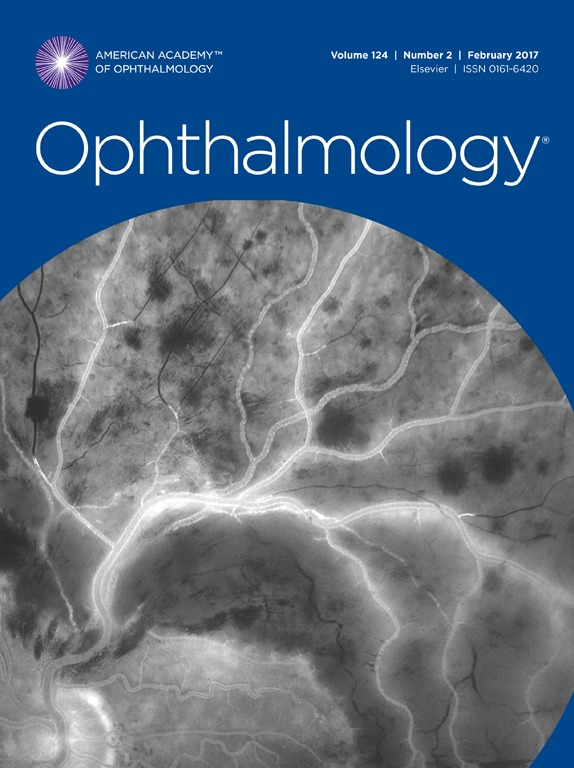临床试验中抗血管内皮生长因子药物眼部并发症的国际分类系统。
IF 13.1
1区 医学
Q1 OPHTHALMOLOGY
引用次数: 0
摘要
目的:与玻璃体内抗血管内皮生长因子(VEGF)疗法相关的并发症在文献中的报道并不一致,因此限制了对不同研究安全性的准确评估和比较。本研究旨在通过德尔菲共识程序,为抗血管内皮生长因子眼部并发症制定一个标准化的分类系统:参与者:25 位国际视网膜专家参与了德尔菲共识调查:方法:根据抗血管内皮生长因子疗法的随机对照试验(RCT)进行系统文献检索,以确定玻璃体内使用抗血管内皮生长因子药物的并发症。从这些研究中得出了一份全面的并发症清单,并对这份清单进行了反复的德尔菲共识调查,参与调查的国际视网膜专家对并发症的纳入、排除、改写和增加进行了投票。此外,调查还确定了所选并发症的具体说明。这一反复过程有助于完善最终的分类系统:主要结果指标:选择纳入或排除抗血管内皮生长因子用药相关并发症的视网膜专家比例:结果:在筛选了 18,229 篇文章后,从 145 项纳入的 RCT 中初步分类出 130 种并发症。参与者通过德尔菲法达成共识,经过三轮筛选,最终纳入了 91 项(70%)并发症。根据参与者的建议做了进一步的修改,如重写某些短语和合并类似术语,之后删除了 24 个多余的并发症,最终共有 67 个(52%)并发症被列入最终清单。共有 14 项(11%)并发症达到了排除阈值,被两轮参与者剔除。德尔菲流程结束后,所有其他不符合纳入或排除阈值的并发症也被排除在最终分类系统之外。此外,根据参与者的一致意见,75 个建议的并发症分类指标中有 47 个(63%)被纳入:结论:通过德尔菲共识程序,为临床试验中的玻璃体内抗血管内皮生长因子药物建立了一个全面、标准化的分类系统,该系统包括 67 种眼部并发症和 47 种独特的分类标准。在未来的试验中采用该系统可提高不良事件报告的一致性和质量,从而促进更准确的风险-效益分析。本文章由计算机程序翻译,如有差异,请以英文原文为准。
International Classification System for Ocular Complications of Anti-VEGF Agents in Clinical Trials
Purpose
Complications associated with intravitreal anti-VEGF therapies are reported inconsistently in the literature, thus limiting an accurate evaluation and comparison of safety between studies. This study aimed to develop a standardized classification system for anti-VEGF ocular complications using the Delphi consensus process.
Design
Systematic review and Delphi consensus process.
Participants
Twenty-five international retinal specialists participated in the Delphi consensus survey.
Methods
A systematic literature search was conducted to identify complications of intravitreal anti-VEGF agent administration based on randomized controlled trials (RCTs) of anti-VEGF therapy. A comprehensive list of complications was derived from these studies, and this list was subjected to iterative Delphi consensus surveys involving international retinal specialists who voted on inclusion, exclusion, rephrasing, and addition of complications. Furthermore, surveys determined specifiers for the selected complications. This iterative process helped to refine the final classification system.
Main Outcome Measures
The proportion of retinal specialists who choose to include or exclude complications associated with anti-VEGF administration.
Results
After screening 18 229 articles, 130 complications were categorized from 145 included RCTs. Participant consensus via the Delphi method resulted in the inclusion of 91 complications (70%) after 3 rounds. After incorporating further modifications made based on participant suggestions, such as rewording certain phrases and combining similar terms, 24 redundant complications were removed, leaving a total of 67 complications (52%) in the final list. A total of 14 complications (11%) met exclusion thresholds and were eliminated by participants across both rounds. All other remaining complications not meeting inclusion or exclusion thresholds also were excluded from the final classification system after the Delphi process terminated. In addition, 47 of 75 proposed complication specifiers (63%) were included based on participant agreement.
Conclusions
Using the Delphi consensus process, a comprehensive, standardized classification system consisting of 67 ocular complications and 47 unique specifiers was established for intravitreal anti-VEGF agents in clinical trials. The adoption of this system in future trials could improve consistency and quality of adverse event reporting, potentially facilitating more accurate risk-benefit analyses.
Financial Disclosure(s)
Proprietary or commercial disclosure may be found in the Footnotes and Disclosures at the end of this article.
求助全文
通过发布文献求助,成功后即可免费获取论文全文。
去求助
来源期刊

Ophthalmology
医学-眼科学
CiteScore
22.30
自引率
3.60%
发文量
412
审稿时长
18 days
期刊介绍:
The journal Ophthalmology, from the American Academy of Ophthalmology, contributes to society by publishing research in clinical and basic science related to vision.It upholds excellence through unbiased peer-review, fostering innovation, promoting discovery, and encouraging lifelong learning.
 求助内容:
求助内容: 应助结果提醒方式:
应助结果提醒方式:


